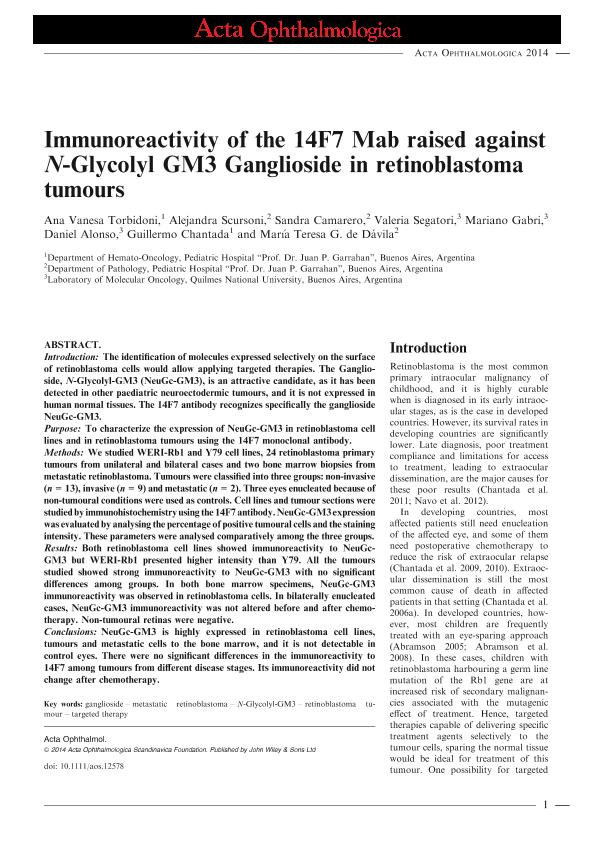Mostrar el registro sencillo del ítem
dc.contributor.author
Torbidoni, Ana Vanesa

dc.contributor.author
Scursoni, Alejandra
dc.contributor.author
Camarero, Sandra
dc.contributor.author
Segatori, Valeria Inés

dc.contributor.author
Gabri, Mariano Rolando

dc.contributor.author
Alonso, Daniel Fernando

dc.contributor.author
Chantada, Guillermo Luis

dc.contributor.author
de Dávila, Maria Teresa
dc.date.available
2018-02-07T14:59:16Z
dc.date.issued
2014-09
dc.identifier.citation
Torbidoni, Ana Vanesa; Scursoni, Alejandra; Camarero, Sandra; Segatori, Valeria Inés; Gabri, Mariano Rolando; et al.; Immunoreactivity of the 14F7 Mab raised against N-Glycolyl GM3 Ganglioside in retinoblastoma tumors; Wiley Blackwell Publishing, Inc; Acta Ophthalmologica; 93; 4; 9-2014; 294-300
dc.identifier.issn
1755-375X
dc.identifier.uri
http://hdl.handle.net/11336/35939
dc.description.abstract
Introduction The identification of molecules expressed selectively on the surface of retinoblastoma cells would allow applying targeted therapies. The Ganglioside, N-Glycolyl-GM3 (NeuGc-GM3), is an attractive candidate, as it has been detected in other paediatric neuroectodermic tumours, and it is not expressed in human normal tissues. The 14F7 antibody recognizes specifically the ganglioside NeuGc-GM3. Purpose To characterize the expression of NeuGc-GM3 in retinoblastoma cell lines and in retinoblastoma tumours using the 14F7 monoclonal antibody. Methods We studied WERI-Rb1 and Y79 cell lines, 24 retinoblastoma primary tumours from unilateral and bilateral cases and two bone marrow biopsies from metastatic retinoblastoma. Tumours were classified into three groups: non-invasive (n = 13), invasive (n = 9) and metastatic (n = 2). Three eyes enucleated because of non-tumoural conditions were used as controls. Cell lines and tumour sections were studied by immunohistochemistry using the 14F7 antibody. NeuGc-GM3 expression was evaluated by analysing the percentage of positive tumoural cells and the staining intensity. These parameters were analysed comparatively among the three groups. Results Both retinoblastoma cell lines showed immunoreactivity to NeuGc-GM3 but WERI-Rb1 presented higher intensity than Y79. All the tumours studied showed strong immunoreactivity to NeuGc-GM3 with no significant differences among groups. In both bone marrow specimens, NeuGc-GM3 immunoreactivity was observed in retinoblastoma cells. In bilaterally enucleated cases, NeuGc-GM3 immunoreactivity was not altered before and after chemotherapy. Non-tumoural retinas were negative. Conclusions NeuGc-GM3 is highly expressed in retinoblastoma cell lines, tumours and metastatic cells to the bone marrow, and it is not detectable in control eyes. There were no significant differences in the immunoreactivity to 14F7 among tumours from different disease stages. Its immunoreactivity did not change after chemotherapy.
dc.format
application/pdf
dc.language.iso
eng
dc.publisher
Wiley Blackwell Publishing, Inc

dc.rights
info:eu-repo/semantics/openAccess
dc.rights.uri
https://creativecommons.org/licenses/by-nc-sa/2.5/ar/
dc.subject
N-Glycoly-Gm3
dc.subject
Ganglioside
dc.subject
Metastatic Retinoblastoma
dc.subject
Retinoblastoma Tumour
dc.subject
Targeted Therapy
dc.subject.classification
Otras Medicina Básica

dc.subject.classification
Medicina Básica

dc.subject.classification
CIENCIAS MÉDICAS Y DE LA SALUD

dc.title
Immunoreactivity of the 14F7 Mab raised against N-Glycolyl GM3 Ganglioside in retinoblastoma tumors
dc.type
info:eu-repo/semantics/article
dc.type
info:ar-repo/semantics/artículo
dc.type
info:eu-repo/semantics/publishedVersion
dc.date.updated
2018-02-06T20:08:34Z
dc.journal.volume
93
dc.journal.number
4
dc.journal.pagination
294-300
dc.journal.pais
Reino Unido

dc.journal.ciudad
Londres
dc.description.fil
Fil: Torbidoni, Ana Vanesa. Gobierno de la Ciudad de Buenos Aires. Hospital de Pediatría "Juan P. Garrahan"; Argentina
dc.description.fil
Fil: Scursoni, Alejandra. Gobierno de la Ciudad de Buenos Aires. Hospital de Pediatría "Juan P. Garrahan"; Argentina
dc.description.fil
Fil: Camarero, Sandra. Gobierno de la Ciudad de Buenos Aires. Hospital de Pediatría "Juan P. Garrahan"; Argentina
dc.description.fil
Fil: Segatori, Valeria Inés. Consejo Nacional de Investigaciones Científicas y Técnicas; Argentina. Universidad Nacional de Quilmes. Departamento de Ciencia y Tecnología. Laboratorio de Oncología Molecular; Argentina
dc.description.fil
Fil: Gabri, Mariano Rolando. Universidad Nacional de Quilmes. Departamento de Ciencia y Tecnología. Laboratorio de Oncología Molecular; Argentina
dc.description.fil
Fil: Alonso, Daniel Fernando. Universidad Nacional de Quilmes. Departamento de Ciencia y Tecnología. Laboratorio de Oncología Molecular; Argentina
dc.description.fil
Fil: Chantada, Guillermo Luis. Consejo Nacional de Investigaciones Científicas y Técnicas; Argentina. Gobierno de la Ciudad de Buenos Aires. Hospital de Pediatría "Juan P. Garrahan"; Argentina
dc.description.fil
Fil: de Dávila, Maria Teresa. Gobierno de la Ciudad de Buenos Aires. Hospital de Pediatría "Juan P. Garrahan"; Argentina
dc.journal.title
Acta Ophthalmologica

dc.relation.alternativeid
info:eu-repo/semantics/altIdentifier/doi/http://dx.doi.org/10.1111/aos.12578
dc.relation.alternativeid
info:eu-repo/semantics/altIdentifier/url/http://onlinelibrary.wiley.com/doi/10.1111/aos.12578/abstract
Archivos asociados
